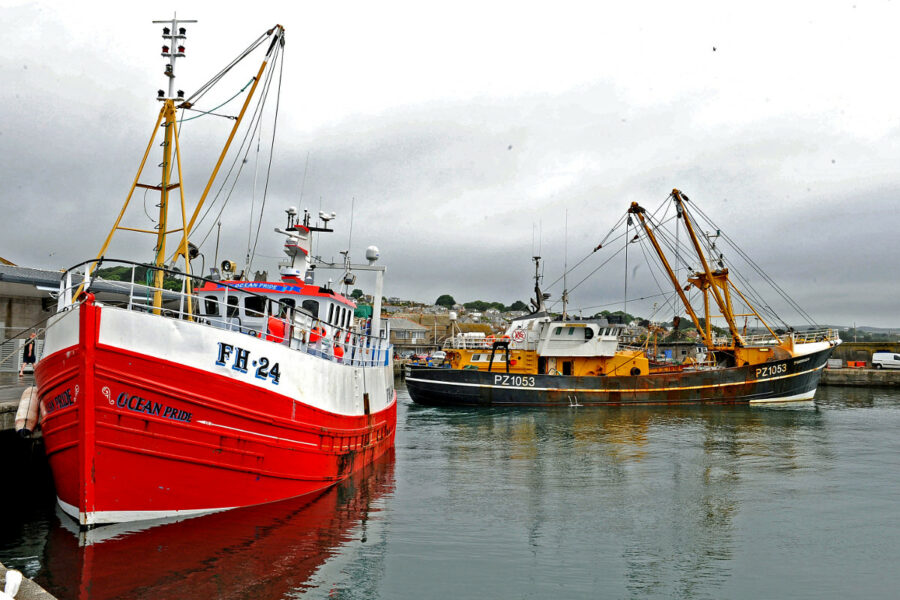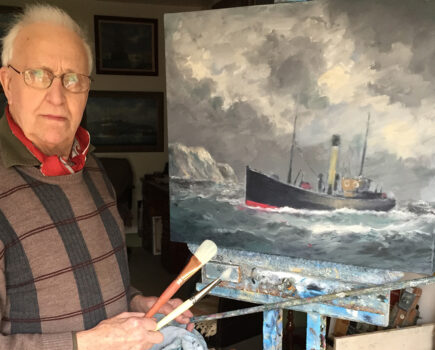With its new fishmarket now reaching completion, confidence among Newlyn fishermen and vessel owners is growing, with new boats steadily joining the fleet. Further plans are underway to bring in new tonnage of purpose-built deep-sea beam trawlers, reports Phil Lockley
Quite different to many West Country ports – if Newlyn lost its fishing industry, there would be little left of the town – fishing is its past, its present, and is vital to its future. And within their budget, Newlyn harbour commissioners are investing heavily to support the port’s indust
ry.
The largest Newlyn beam trawler fleet (owned by W Stevenson and Sons Ltd – now referred to as Stevenson’s of Newlyn) is prospering, but the structure of that fleet is now under review, and some vessels may, in time, be replaced by boats better able to tackle the Western Approaches, seeking prime fish like megrim and monkfish – core species for Newlyn.
And ‘doing what it does best’ is a Newlyn trait shared by the port’s netting fleet – many continue to promote the MSC-accredited Cornish hake. Newlyn hake skipper Alan Dwan (Ajax PZ 36) was joint winner of Demersal Fisherman of the Year category in the Fishing News Awards 2018.
The success of deep-water mono-netting has drawn investment to Newlyn from South Devon-based vessel owner Waterdance Ltd, which has purchased and refitted a fleet of vessels to become some of the most advanced netters in the UK. Waterdance netters are now a formidable sector of the Cornish fishing industry.
Non-company Newlyn vessel-owners are not holding back either, and over the past couple of years, they too have invested in better boats.
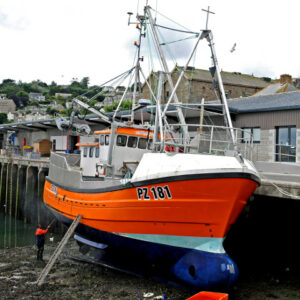
Newlyn ring-netters may have a tough time ahead, until ICES reassesses its precautionary advice on Cornish sardines.
Now on the minds of both Newlyn fishermen and its fish merchants is what may come after Brexit. Some are despondent, believing that the British government will not keep its promise – it will capitulate in forthcoming EU/UK deals, and fail to regain for Britain the status of a truly independent coastal state.
But not all Newlyn folk are strong Brexiteers. In many respects, the needs of Newlyn are so similar to those of ports in Brittany that the outcome of a hard Brexit may not be in Newlyn’s favour. Many Newlyn boats fish in French waters, and some often land there – and over 70% of fish and shellfish landed in Newlyn is exported to the EU.
There was shock this year when the crabbing industry at Newlyn – and at all other Cornish ports, too – saw a sharp downturn in the catches of brown crab. And with the unpredicted absence of mackerel, the smaller-boat fishermen of Newlyn now fear a bleak outcome overall for the remainder of 2018. However, there has been a remarkable run of lobsters, and a promising influx of juvenile crawfish.
Most sardine ring-netters are based in Newlyn. With the start of their season just days away, hopes of a bounteous winter have been dampened by the precautionary advice on available stock.
With little warning, last year ICES split its management of the European sardine stock into two sectors. Previously, the stock was considered as one, running from Biscay to Ireland, but now that has become two stocks, one in Area VII and the other in Area VIII.
West Country ring-netters fish just a small part of Area VII, and have been dealt a bad hand. They now have no option but to bear the brunt of ICES’ ‘precautionary advice’ and follow a voluntary code of conduct – and, until ICES reassesses the stock, must stick to catch limits and put up with a significant cut in their earnings.
The wide mix of boats in the Newlyn fleet includes a strong representation of inshore toshers, for which prime-quality line-caught bass and mackerel have long been of crucial importance. This is reflected by the broad range of species that contributed to the provisional 2017 port value total of £29.6m from 13,505t. These figures correspond to a 9% increase in catch value and a 4% drop in tonnage, mainly due to variations in catch composition over the course of the two years.
Depending on the seasonal nature of their fishing activity, and the area they are fishing in, some of Newlyn’s prominent fleet of netters sometimes land their catches directly into France, while several other local boats consistently consign catches from Cornwall, for sale on Plymouth and Brixham markets.
With a value of £19.2m from 6,525t, demersal species continue to dominate landings at Newlyn (65%). Shellfish (£8.9m/3,211t) account for a further 30% of the port’s annual catch value. (See Table 1)

Landed by both mobile and static-gear boats, monkfish (£4.4m/1,478t) is the single most important species at Newlyn. The unprecedented abundance of hake now on the grounds west of Newlyn saw this species (£3.8m/1,413t) further consolidate second place in terms of catch value, ahead of cuttlefish (£2.6m/735t) which jumped from eighth place to third as a result of exceptional fishing in the last quarter of 2017. Fourth-placed sole (£2.2m/208t) was marginally ahead of megrim (£2.1m/820t).
Catches of crabs (£1.9m/1,107t), scallops (£1.7m/745t), Nephrops (£1.7m/478t), turbot (£1.3m/140t) and lemon sole (£1.2m/259t) also exceeded £1m in 2017, further underlining the broad mix of species landed at Newlyn. (See Table 2)

Another Cornish Cat
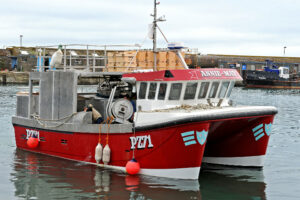
Annie May waiting at Newlyn to take ice for its recent maiden trip.
Completed recently by H Baumbach and Sons at Hayle, the catamaran Annie May PZ 71 is the latest addition to the netting fleet at Newlyn.
Cornish skipper James ‘Bo’ Bosustow bought the Gemini G10 catamaran after hearing its part-build was on hold. Having been impressed with other catamarans, James clinched a deal and brought the vessel to Cornwall for Alan Baumbach to finish the work.
H Baumbach and Sons made all the changes that skipper Bosustow required to the hull, wheelhouse, enginerooms and deck layout, and Annie May recently completed its maiden trip as a true high-quality ‘Baumbach boat’.
With an alloy shelterdeck, the impressive Annie May adds to the small but prosperous fleet of catamarans working around the Cornish coast – many being based on Gemini hulls.
Further details of Annie May will be included in Fishing News shortly.
New fishmarket gets thumbs-up – with new boats on the way
Described as ‘fantastic’, the new fishmarket at Newlyn – owned and operated by Newlyn Pier and Harbour Commissioners (NP&HC) – gets a thumbs-up from the port’s largest trawler owners, W Stevenson and Sons Ltd (Stevenson’s of Newlyn).
In the final phase of its construction, the new fishmarket may open up considerable potential for all businesses in Newlyn, predicts Stevenson’s leader, chief executive officer Peter Aylott. Sharing the present upbeat mood in Newlyn, he reveals how part of the Stevenson’s of Newlyn beam trawler fleet may be replaced by new builds.
He explained: “We already have a very productive fishing fleet, but some of the tonnage is quite old. We have taken steps internally to renew some of the (beam trawler) tonnage, but, until recently, we had not considered buying new boats. We are keeping our options open, but looking around the second-hand market for boats suitable for our type of fishing has, so far, not been successful.
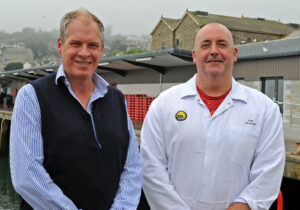
Peter Aylott (left), CEO of Stevenson’s of Newlyn, and the firm’s chief auctioneer, Ian Oliver, give a thumbs-up to the new market at Newlyn.
“Our skippers need deeper-drafted boats, and boats with greater deck space, than many smaller boats that work in the English Channel and/or Bristol Channel. Stevenson’s of Newlyn’s skippers and crewmen need boats that can cope with the big swells in the Western Approaches, so boats such as Eurocutters are of little use to us. For a large part of the year, our boats work a considerable way into the Western Approaches.
“We are looking at boats of 30m in overall length, having a registered length of under 24m – boats similar to Billy Rowney PZ 532 (31.86m x 27.34m x 7.5m), but boats with better fuel efficiency. Regarding vessel size, there is a cut-off point on profits; we don’t want boats of 35m in length. Other firms have, in the past, tried such boats, and it hasn’t worked.
“Restructuring the Stevenson’s of Newlyn fleet is a long-term and progressive plan – probably 10 to 15 years, and decisions won’t be made before we see the true economic effects after Brexit. We need to see how quotas and licences might work in the future.
“Newlyn is the premier whitefish port of England and Wales. Looking at landing figures of other South West ports (Brixham and Plymouth), those figures are impressive, but they are boosted by species such as cuttles and scallops, and pelagic fish too. However, when the landings of whitefish across the ports are considered, Newlyn is in the lead.
“Brixham and Plymouth are important players, but at Brixham, the doubling of the cuttlefish price in such a short time has increased the figures quite a lot. Let’s hope that the high price for cuttles continues, but such species and prices can fluctuate considerably. We are principally a whitefish port, and prices of whitefish are more stable.
“Newlyn is a vibrant port. Increased monies coming into the harbour are driving the infrastructure, and we see the new market as a result. While the market is still under construction there are challenges facing us all, but once it is complete, I cannot see any prospect other than the new market being great news.”
Auction by species, rather than by boat
Low prices paid for small quantities of individual species are often a nightmare for small-boat fishermen.
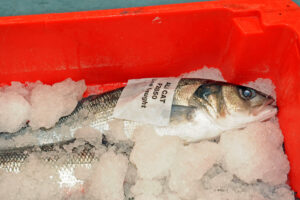
While small landings of line-caught bass will get high prices, the same amount of other whitefish may not.
“Big buyers avoid small quantities of fish and often walk away, leaving smaller buyers to reap the benefits and win from much lower bids,” explained chief auctioneer, Ian Oliver.
For many years, he and auctioneer Ryan Ladd have witnessed that far too often, ‘and it is now time to stop that practice’, he said.
Ian Oliver added, “We hope to prevent it by auctioning those fish ‘by species’ and not ‘by boat’ – but to do so, we may need a new small grading machine, one devoted to small-boat landings. This would mean a further investment from Newlyn Pier and Harbour Commissioners, and we have discussed it.
“In addition to protecting small landings, such a facility would take away the laborious process of hand-grading line-caught mackerel, something that, at present, the skippers must carry out. We are sure that those fishermen would welcome it.
“I would like to see small amounts of fish landed from inshore trawlers, netters and cove boats have a fair chance on the market. At present, we see instances where a small boat might land, say, a few kilos of high-quality lemon sole, but bigger buyers are not interested and the price drops dramatically. If we had all such fish auctioned together, bigger buyers would take their share, and small buyers would also have a chance, but would have to compete on a level playing field.”
Will a second auction company be appointed?
Stevenson’s of Newlyn is now a multiplex business: vessel owners, wholesale fish merchants, exporters, retail shops, fuel suppliers, auctioneers and more.
CEO Peter Aylott explained how those sectors run separately, each with different perspectives, and how the company has auctioned fish at Newlyn for ‘many decades’.
“At present, we are the only auctioneers at Newlyn, and provided that the infrastructure allows it, we expect to continue to do what W Stevenson and Sons Ltd has done for a very, very long time – auction fish to get the highest possible price for every fish landed to the market.
“We understand that Newlyn Pier and Harbour Commissioners (NP&HC) are considering a second auctioneer. Indeed, we understand that funding for the market may require a tender process for a second auctioneer.
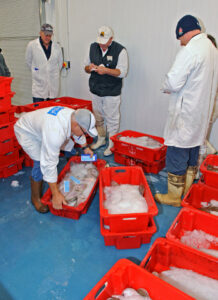
Chief auctioneer Ian Oliver logs the megrim sole bought by one of the largest South West fish buyers and distributors, Falfish.
“Stevenson’s of Newlyn is open to the challenges that may unfold, but we struggle to see how two auction companies will successfully operate together. It doesn’t happen at any other South West fishmarket. It will make things very difficult; you will have the issue of how and when the boats should land, and there will always be a challenge between auctioneers on how to manage the market.
“Commercially, unless one auction company is very much larger than the other, Newlyn would be a difficult place to operate two auction companies. What would happen if our beamers landed at the same time as those landing to the other auction company?
“Newlyn fishmarket and/or NP&HC wouldn’t be able to cope with that amount of fish.”
Chief auctioneer Ian Oliver explained: “We work very hard to prevent over-supply to the market, and the fishermen also work hard to stagger the landings, to get the best possible price for their fish. We are also aware of what over-supply might do to a skipper’s quota allocation; skippers cannot waste their quota when, due to ill-managed bulk landings, the prices slump.
“Until a few years ago, we often faced over-supply. It wasn’t rare to see the market awash with fish one day, and then, the next day, we had nothing. It is so frustrating to the auctioneers to see good prices paid at the start of the market, and then see prices for equally good fish steadily drop away – and then to hear people complain about what was unavoidable.
“Thankfully, that no longer happens at Newlyn market, and communication is a very important factor. We have worked very hard to avoid over-supply, and the fishermen have also worked hard to prevent any over-supply – we want to achieve the best prices for every fish being auctioned.
“If we see any threat of over-supply, we may advise skippers to remain at sea for slightly longer, or to come in earlier, or if the price is unexpectedly too low, we might hold back some fish, or send it to another market – anything rather than seeing the fishermen at Newlyn get low prices. It is all down to good communication. A feather in our cap is that over-supply at Newlyn market rarely happens.
“There are other future issues to consider – such as the auction taking place via an internet clock. Newlyn is a very remote place, and the internet clock may not be suitable. Although some may like it, others say they don’t want it; small buyers are very concerned about a clock auction. It might not be the right step forward for Newlyn – but at the end of the day, that is not our decision, but one taken by NP&HC.
“I take a very open view on it. Every day, I watch prices at clock auctions, and I don’t see any difference in prices to ours – indeed, many times we are higher. But whatever the outcome for Newlyn fishmarket, it won’t change our drive to remain as auctioneers for many years to come.”
Peter Aylott – recently appointed CEO of Stevenson’s of Newlyn
Experience at sea is something that Peter Aylott, the new CEO of Stevenson’s of Newlyn, has plenty of. After leaving Oxford University, he spent 16 years in the Navy. During his career he spent time in charge of navigation aboard HMS Ocean, where he describes his work as ‘very long hours, but fascinating’.

Peter Aylott.
Earlier, Peter Aylott spent time aboard the fisheries protection fleet, on ships such as the corvette HMS Leeds Castle and the minesweeper HMS Ledbury, and he was in charge of HMS Cattistock, a Hunt-class mine countermeasures vessel. Peter Aylott says he is well aware of the sea conditions in places like the Western Approaches, where the Stevenson’s of Newlyn fleet often works.
He said: “I left the Navy to join a worldwide offshore company, C-MAR Group, as chief operating officer, looking after oil rigs, pipe-laying ships, and all sorts of vessels and platforms in the offshore industry. After nine years there, I left to join Stevenson’s of Newlyn last December.
“The firm remains a large part of Newlyn; the Stevenson’s of Newlyn fleet is profitable, and has great potential. Part of our ancillary wholesale fish business has grown by 50% over the past two years, Stevenson’s of Newlyn retail shop is doing very well, and throughout all parts of the group, our staff are doing a good job.
“By September, Newlyn Pier and Harbour Commissioners will complete the full refurbishment and modernisation of its fishmarket, although there remains the question of the second auctioneer.
“On the restructuring of the Stevenson fleet, it will take some time. Boats like the St Georges and the Billy Rowney may remain for a very long time, but others may be replaced sooner by new tonnage.
“It is a fantastic time to join a company like Stevenson’s of Newlyn. There are great opportunities ahead for the fishing industry at Newlyn. The harbour master, Rob Parsons, is doing a superb job, and already there is talk of facilities being further improved; all sorts of ideas are under discussion. Is there a more fascinating time than right now to be engaged in the UK fishing industry? In my opinion, there isn’t, and I am glad to be part of it.”
Newlyn rules – 1885
Newlyn fishmarket began in the 1800s, when things were just getting out of hand, explains a recently-published book, The Story of Newlyn Harbour.

Being a Newlyn harbour commissioner was not a job for the faint-hearted in the late 1800s!
The book was lottery-funded and published by Newlyn Archive, and sections of it are based on old harbour logs, diaries and paperwork discovered by Newlyn harbour master, Rob Parsons, who passed them on to the historians. There were so many documents that they filled 13 fishboxes.
Rob Parsons said: “I discovered the logs in a store that was in dire need of refurbishment. Had they been left any longer, all would have perished, and much of the port of Newlyn’s fascinating story would have been lost forever. Having only just taken on the job of harbour master, I was unaware of the Newlyn Archive, so when my deputy Ollie suggested passing them on, it was an easy decision. The rest is history.”
Local historians Pamela Lomax and Linda Holmes helped to produce and edit a remarkable book – one that suggests that Newlyn harbour commissioners of 1884 had tasks equivalent to that of a police force.
With a wry smile, Rob Parsons added, “Recently, I was asked what I would have done in Newlyn back in the days of 1884. Joined the Royal Navy, and left them to it!”
No fishing on a Sunday was a fiery topic, and God-fearing Newlyn fishermen were so fed up with the visiting east-coast fishermen – who openly flouted the Sunday rule – that two years later they were to defend that law in what became known as the ‘1896 riots’.
Unlike many over-detailed historic books, The Story of Newlyn Harbour gives a step-by-step record of the port’s history, revealing how being a fisherman, shore worker or harbour commissioner in those days was not a job for the faint-hearted. Described as a ‘must-have for all’, The Story of Newlyn Harbour can be purchased for £8 from Newlyn Archive: newlynarchive.org.uk
Facts about Newlyn fishmarket
Newlyn lies adjacent to some of the richest fishing grounds in the northern hemisphere.
Newlyn Pier and Harbour Commissioners (NP&HC) recognise the iconic harbour as the fulcrum of Cornwall’s fishing industry, and aspire for it to become the UK’s leading fishing port.
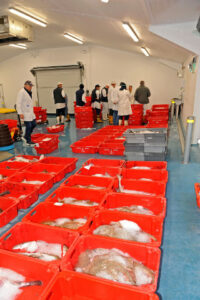
Better facilities from the £1.3m investment in the new fishmarket at Newlyn.
NP&HC is therefore committed to providing fit-for-purpose infrastructure and services to support the development and sustainability of the fishing industry.
Currently, 30% of the fish landed at Newlyn is transported to Plymouth for sale, where clock auctions are thought to achieve better prices. Online auctions increase the number of potential buyers, providing greater reassurance that the best possible price has been obtained, and harbour staff provide a range of essential services. This, of course, adds haulage to the cost of sales.
Underpinned by ongoing investment in maintaining existing infrastructure, Newlyn fishmarket is currently being enhanced to ensure that it offers the full range of modern services needed by the changing industry. This will include a review of how the auction service might be improved to reflect the developing preference for direct selling to retailers, processors or merchants who are able to add value through logistics and marketing.
Funded by the European Maritime and Fisheries Fund and NP&HC, this 18-month £1.3m refurbishment project is an important step in the history of Newlyn. Key features of the development include a fully refrigerated market, solar panels, and tech-enabled office facilities.
Phase 1 of the new-look Newlyn fishmarket opened for business in April 2018, and Phase 2 will be completed next month.
Apart from the strategic importance of retaining a fishmarket in Cornwall, the community of Newlyn will benefit economically from this development and enable NP&HC to support fish-processing and other value-added activity in the locality, as well as reduce haulage costs for the Newlyn fishery.
Increased revenues will enable NP&HC’s further investment in maintaining the fabric of the fishing quays, and marketing initiatives to promote the superlative quality of Cornish fish.
Say NO to the clock auction
While some Newlyn fish merchants may welcome a clock auction (with remote bidding proposed), many do not, says buyer Julian Smart, who told Fishing News that such a drastic move, ending the shout auction, would sever Newlyn’s fishing industry from its heritage.
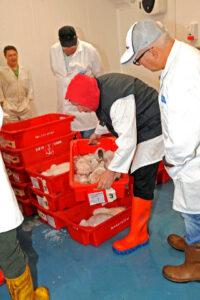
A clock auction would ruin small-scale fish businesses, and remove the heritage of Newlyn, say many buyers.
Newlyn harbour commissioners have yet to make a decision on whether its new fishmarket will move to a clock auction.
“Moving to a clock auction, particularly a remote clock auction, may threaten the livelihoods of all those employed in small-scale fish businesses,” said Julian’s father, Dave Smart, founder and director of Smarts Prime Fish, based at Crowlas, near Penzance.
Dave Smart, who holds a doctorate in fishing history, says the call for a clock auction has emerged from the ongoing regeneration project in Newlyn, and will have catastrophic effects on the infrastructure of Newlyn as a town. Many associated businesses would not be able to survive.
In 2007 he wrote and published a brochure, ‘Something to Shout About’, in which his fears about the prospect of an electronic auction at Newlyn were clearly spelt out. This was circulated to other buyers, and it was revised in 2009, and again a few weeks ago. He believes his reasons for keeping the shout auction are so compelling that the people of Newlyn should ‘quickly realise’ that an electronic auction ‘may destroy so many of the good points of the port’.
“Now is an excellent opportunity to preserve the traditional shout auction,” he added.
“It need not disappear forever. We should be forward-thinking enough to realise that if an electronic auction was installed, then the character of the market would be lost completely; a procedure carried out in a closed room, and sited somewhere around the present fishmarket, would be a disaster.”
He is appealing to merchants of a similar mind at Brixham, and hopes they may try to prevent their shout auction coming to an end.
A merchant at Brixham told Fishing News: “Other than two or three of the big buyers, I don’t know of one buyer at Brixham who wants a remote clock auction. It will be a nightmare, and it doesn’t matter which buyer it is, it will open a can of worms for everybody connected with Brixham fishmarket.
“I have been to ports with remote clock auctions and have seen the outcome, and I don’t think the leaders of Brixham market realise what chaos it will bring.
“We, as a firm, don’t want to adapt, but we might be able to. But how about the small buyers? And there’s more of those than the big buyers, far more, and collectively they provide far more employment, too. Without a doubt those firms will go bust – closed down simply because of a clock auction. I really feel for the lads at Newlyn.
“But a message to the fishermen here in Brixham – what more do they want? Sole on Brixham market today (6 July) made £22/kg. If they (the fishermen) think they will find a better price from using a remote clock auction, good luck – but where from? They will, in the end, rue the day that a remote clock auction was fitted.
“As an example, will they get their wages from the 20t of cuttles that they landed? There is a big risk that ‘no’ will be the answer. What will happen to their wages when a buyer on the continent pushes a button and buys that 20t, and so it is packed and shipped, but when it gets to that buyer, he says the quality is poor and he won’t pay for it? It will be six days before those cuttles get back to Brixham – if they ever do.
“Having a remote clock auction will be a nightmare, and examples like that with the cuttles will be commonplace – companies going bust one after the other. But to the authorities who think the clock auction is the answer: again, good luck, because you will literally throw your port into chaos, and what will the fishermen think of you then?”
Dave Smart added, “There are other important reasons why the Newlyn shout auctions should remain, heritage being one. All sorts of people are fascinated to see how fish is sold: to see the fish, watch the auction in progress, and see the buyers bid – and to watch the buyers talking to their customers on the phone, and then fiercely bid for the fish they must have.
“When the general public see fish in a shop, few of them have any idea how it got from the boat to the shop. People are fascinated by a shout auction, but I’m sure they will switch off when seeing people sitting in a room pressing buttons.
“As relatively small buyers at Newlyn, allowing the public to have the experience of seeing a shout auction is very important to us. A shout auction in action is probably one of the best ways of promoting fish available in Britain today.
“A shout auction is a genuine, traditional way of selling fish. Buyers are able to view the laid-out fish at their leisure and bid accordingly. If a buyer has contracted with his or her potential customer to acquire particular fish, then the buyer at a shout auction can guarantee to buy that fish by being the last to ‘shout’ the highest price. This is not guaranteed on an electronic auction, where the clock goes anticlockwise from higher to lower price. Small buyers cannot take the risk.”
Julian Smart added, “At a shout auction, if I see the best quality – of hake, say – I spot a few boxes with fish better than in the other boxes, so I go over the top on the bid to get them. I win the bid, and watch my labels being put in the boxes, and I see those boxes loaded onto my vehicle. I know that, back at the factory, I will unload exactly what I paid for.
“But how am I to have any idea, or proof of that, on a clock auction? After a sale, the tickets are printed and could be stuck on any box of that species. That’s not a risk that I want to take, and nor do most other buyers at Newlyn.”
Newline Chandlery moving to new depot
With increased throughput of fishing gear and chandlery, Newline Chandlery, a popular firm based at Newlyn, has struck a deal to move to bigger premises less than 50 yards away ‘as soon as possible’, said the firm’s boss, Neal Turner.
Its new depot is part of Newlyn harbour, and was previously used by Mount’s Bay Engineering.
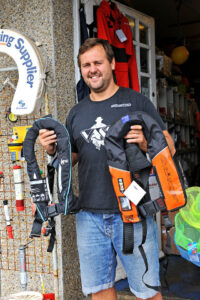
Neal Turner showing just two of the makes of lifejacket on sale at Newline Chandlery – right is the Challenger and left is the Kru.
Newline Chandlery began trading 17 years ago, and has become a significant supplier of fishing gear across the South West. The firm supplies its products directly from its shop, and by mail order through its website: newlinechandlery.co.uk
Steadily increasing sales prompted Neal Turner to find bigger premises, to enable most of his firm’s stock to be on show, he told Fishing News.
“Basically, the present shop is so small that a lot of stock is in our storeroom; fishermen often like to browse before deciding what they want to buy, and with bigger premises it will soon be possible. I understand that maintenance work to the building must take place before we can move, but hopefully that will take place quite soon.
“We have had a good year, and sales in general have increased, but the demand for rigged nets has fallen, in particular for the small boats, and many small-boat skippers and crewmen have so far had a poor year.
“Skippers now re-rig or mend their old gear and on that, we have seen a strong order book for mono sheets and rigging gear, but overall the sales of rigged nets have fallen since 2010. And across the whole fishing-gear market, prices from the manufacturers have moved up – suppliers of net materials may blame their price rises on the cost of oil, and other makers blame the subsequent rise in metal prices – and the rising costs across the fishing industry as a whole are being felt.
“However, there is always a stark difference between the leisure industry and the fishing industry. The leisure market might quibble about those price rises – even though the increases are out of our control – but fishermen cannot afford to wait. They need the gear to get back to sea as soon as possible, and our stocks of all products reflect that.
“We supply a wide range of gear, and have responded to recent EMFF grants being available to fishermen to help improve their safety at sea. Many are taking their safety at sea more seriously than they did 20 years ago. We carry a significant stock of all safety equipment, including PLBs and EPIRBs, and promote new lifejackets from Challenger and from Kru, giving skippers a chance to compare those against others promoted in the fishing industry previously.”
Neal Turner explained that both Challenger and Kru jackets do not have hard fabric on the inner neck section, as some other makes do, and both of these lifejackets have strong zips. The Challenger jacket has a neat rear cover to take the weight of the jacket from the neck, and distribute that weight across the shoulders.
He added, “Safety is one of the biggest parts of our business. Between official MCA (lifejacket) inspections, fishermen can have free lifejacket checks at Newline Chandlery. If there is a fault, we can point that out to them, and if the fisherman wants, we can put it right. We can service lifejackets and/or have them tested at any time.”
Confidence in Brexit deal remains – CFPO leader Paul Trebilcock
Paul Trebilcock, leader of the Cornish Fish Producers’ Organisation (CFPO), remains confident that the UK government will step up, and not only assume its legal rights as an independent coastal state, but genuinely act as one by taking full control of fisheries management within the British Exclusive Economic Zone (EEZ) following the implementation period, as the UK enters the post-Brexit era.
However, his confidence is cautious, and was dented by the UK government’s surrendering of UK fisheries management to the EU’s CFP during the implementation period – despite assurances this would not be the case.
In a recent interview with Fishing News, Paul Trebilcock – previously chairman and latterly president of the National Federation of Fishermen’s Organisations (NFFO) – gave his thoughts on what the future may hold for Cornish fishermen.

Paul Trebilcock.
Fishing News: Following Brexit, will the Cornish fishing industry (at ports like Newlyn) have scope to develop further, and will its industry prosper as a result?
Paul Trebilcock: I think the key is that there are significant opportunities for the fishing fleet that could deliver genuine improvement, in terms of sustainable fisheries management, that will lead to increased fishing opportunities, landings and values of fish and shellfish landed by the Cornish fleet, as well as protection and opportunities for our important non-quota-targeting fleets (such as crabbers and netters currently facing gear conflict issues with EU trawlers).
These benefits should cascade down to ports and harbours, like Newlyn, as well as processors, merchants, and the whole range of shoreside ancillary businesses. This will hopefully lead to additional investment in both fleet and infrastructure projects, as well as the continuation of existing important (and long overdue!) investments, such as the Newlyn market upgrade.
Cornish ports and harbours (as well as others around the UK regions), and the shoreside businesses that support the fishing industry, should have the opportunity to modernise and be maintained properly, in line with the improving fortunes of the fleet.
Politically, the rhetoric is positive, and fishing seems to remain well up the political agenda. In the past few months we have had several visits and meetings with MPs and ministers across the political spectrum, including Michael Gove (secretary of state for Environment, Food and Rural Affairs), George Eustice (UK fisheries minister), Steve Baker (Brexit minister), Brandon Lewis (cabinet minister and chairman of the Conservative Party), Tom Brake (Liberal Democrat Brexit spokesman), and most of the local Cornish MPs.
All have been positive about what can be secured, and have highlighted some of the challenges in achieving the good deal the fishing industry deserves.
The inequity of relative stability stands out as a stark and real illustration of how bad the EU entry deal was for Cornish fishermen. As an example, the UK has 10% of the Area VII haddock TAC, compared to the French 65% share, when the majority of the stock is found in UK waters.
This is compounded by the asymmetric access rights of the CFP, allowing modern EU vessels with up to 1,000hp to fish alongside Cornish day boats into the six-mile limit, with seemingly limitless quota in comparison to UK boats, and a disregard for inshore static-gear fishermen.
Every politician or MP we have spoken to, about the experiences of fishermen from Cornish ports like Mevagissey, Looe, Helford, Newquay, Padstow and Newlyn, fishing under the flawed CFP, has taken those facts onboard.
Obviously politicians are sometimes accused of only showing an interest in fishing for photo opportunities, and to keep the fishing industry onside through the implementation period, while ultimately being prepared to see fishing traded away for the ‘greater’ good of the UK.
That is a genuine risk, and a real fear for many Cornish fishermen, but I don’t believe that it will happen.
Brandon Lewis MP, a non-DEFRA-related minister who is a member of the cabinet, was very clear that most in the cabinet realise the political importance of our fishing industry, and was equally clear in his assurance that the final deal would recognise this.
Some will suggest political naivety, or even that cautious optimism is itself overly optimistic. However, when has the fishing industry ever had such strong and open support from a UK secretary of state (Michael Gove), a UK fisheries minister (George Eustice), and many other Conservative MPs and opposition MPs (like Holly Lynch, Labour and Tom Brake, Liberal Democrat)?
The rhetoric and words have been ambitious and generally positive, and it is now time for the UK government to deliver for UK fishermen.
Fishing News: How confident is the Cornish FPO that fisheries minister George Eustice will deliver a recent promise he made: that after Brexit, the 0-12 mile limit around the shores of Britain will be for UK boats only?
Paul Trebilcock: The 0-12 mile limit for the exclusive use of UK vessels is an important issue for CFPO members. George Eustice has said he can deliver this, and we have no reason to disbelieve him.
Outside the 12-mile limit there is a different set of negotiations, but the bottom line has to be that the UK, as an independent coastal state, and not the EU, will determine who fishes, what they fish for, and how they fish within the UK EEZ. That might, or might not, include access for other EU fleets, but it must be on our terms.
It is important to remember that we (certainly within the CFPO membership) have vessels that fish outside of the UK EEZ. For example, our MSC hake fleet sometimes operates outside the UK EEZ, as do our beam trawlers operating to the south, and scallop boats that work the Baie de Seine area from time to time.
I would think that some sort of balanced reciprocal agreement will be reached to accommodate these parts of the fleet where necessary, unlike the current unfair and totally asymmetric arrangements we have under the CFP.
The many MPs and politicians who have visited Cornwall have stated clearly that the Brexit agreement will be positive for fishing, and I find it hard to believe that the UK government would again betray its fishing industry.
Net haulers selling well
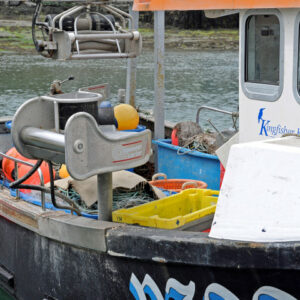
A Spencer Carter NHO-02 self-hauling netting winch is fitted to the Newlyn-based Go For It.
Winch-maker Spencer Carter Ltd reports a strong order book on its NHO-02, the medium/small net hauler introduced in the summer of 2016.
Able to have either right-hand or left-hand ‘hook’, the NHO-02 covers all layouts on fishing vessels, working either port or starboard side, or with a forward or aft wheelhouse.
Technical boss of Spencer Carter, Richard Carter, explained: “The NHO-02 is a new generation of self-hauling netting winches in our range. We have had the hauler in production for well over a year, and it has been very well received, working in depths of over 45 fathoms.
“It is an extremely powerful winch, it can haul as fast or slow as the skipper wishes, and it is user-friendly. It doesn’t box in the net, allowing everything to come through the hauler, but letting the skipper have easy access to the net at any time. Fishermen working crayfish or lobster, or anything else that needs delicate passage through the hauler, by using the NHO-02 to its full advantage, can make sure there are no losses of any part of the animal. One dead crayfish means a considerable loss of wages. It is points like that on which the NHO-02 was designed, and on which it is based.
“We’ve had the NHO-02 fitted to boats as small as 20ft in length, and as big – in one case – as a 9.9m Gemini B10 catamaran. In all situations the NHO-02 works extremely well – that is the feedback we are receiving from our customers, which of course we are pleased about.”
Details of the hauler are available from the firm’s main factory by phone on: 01326 373423 or by email: info@spencercarter.com
Any nets to loan?
A loan of mono nets and (if possible) old barked nets would be welcomed by visual artist, writer and curator, Zsuzsanna Ardó, who will be holding an exhibition of her work in St Ives from 5-12 September.
Likening her exhibition to the saying ‘water, water, everywhere, but not a drop to drink’, she told Fishing News, “Like fish and fishermen, I am at ease in, on, under or being by water – so fishermen and myself have something important in common.
“I’m currently fishing for some used monofilament nets and, if possible, old barked nets. Might some of you fishermen out there have some nets to loan me for a few days?
“The nets would become part of an exhibition during the first week of the St Ives September Festival in the Fishermen’s Workshop at Porthmeor Studios and Cellars. The exhibition, entitled ‘Water, Water Everywhere, Not a Drop to Drink’, is inspired by the space where fishermen prepare and make their nets.
“Incorporating old/new fishing nets in the exhibition will resonate with the exhibition. The local fishing industry in St Ives is a perfect example of how fishing was, and remains, a method to gain food – an industry that has been vital to us all for many thousands of years. Sources of the nets will be acknowledged in the exhibition.”
Zsuzsanna Ardó can be contacted through her website: ardo.org/contact/

